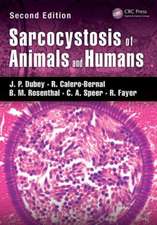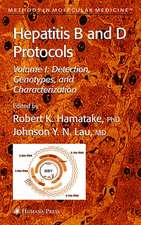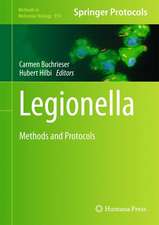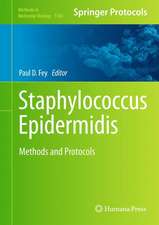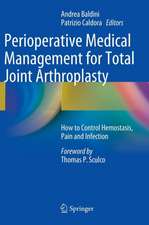Hepatitis C Protocols: Methods in Molecular Medicine, cartea 19
Editat de Johnson Y. N. Lauen Limba Engleză Paperback – 21 aug 2013
Din seria Methods in Molecular Medicine
- 5%
 Preț: 1278.74 lei
Preț: 1278.74 lei - 15%
 Preț: 655.78 lei
Preț: 655.78 lei - 5%
 Preț: 1106.50 lei
Preț: 1106.50 lei - 5%
 Preț: 727.44 lei
Preț: 727.44 lei - 5%
 Preț: 1108.72 lei
Preț: 1108.72 lei - 15%
 Preț: 650.55 lei
Preț: 650.55 lei - 5%
 Preț: 735.66 lei
Preț: 735.66 lei - 18%
 Preț: 947.35 lei
Preț: 947.35 lei - 18%
 Preț: 948.92 lei
Preț: 948.92 lei - 5%
 Preț: 1114.54 lei
Preț: 1114.54 lei - 5%
 Preț: 1114.91 lei
Preț: 1114.91 lei - 15%
 Preț: 658.55 lei
Preț: 658.55 lei - 5%
 Preț: 734.01 lei
Preț: 734.01 lei - 5%
 Preț: 1111.61 lei
Preț: 1111.61 lei - 5%
 Preț: 1104.32 lei
Preț: 1104.32 lei - 5%
 Preț: 723.21 lei
Preț: 723.21 lei - 5%
 Preț: 1106.13 lei
Preț: 1106.13 lei - 5%
 Preț: 723.05 lei
Preț: 723.05 lei - 5%
 Preț: 1108.35 lei
Preț: 1108.35 lei - 5%
 Preț: 723.42 lei
Preț: 723.42 lei - 5%
 Preț: 1115.65 lei
Preț: 1115.65 lei - 5%
 Preț: 786.86 lei
Preț: 786.86 lei - 5%
 Preț: 1133.01 lei
Preț: 1133.01 lei - 5%
 Preț: 1114.71 lei
Preț: 1114.71 lei
Preț: 386.11 lei
Preț vechi: 406.42 lei
-5% Nou
Puncte Express: 579
Preț estimativ în valută:
73.88€ • 77.35$ • 61.13£
73.88€ • 77.35$ • 61.13£
Carte tipărită la comandă
Livrare economică 05-19 aprilie
Preluare comenzi: 021 569.72.76
Specificații
ISBN-13: 9781489943484
ISBN-10: 148994348X
Pagini: 644
Ilustrații: XXI, 621 p. 171 illus.
Dimensiuni: 152 x 229 x 34 mm
Greutate: 0.85 kg
Ediția:Softcover reprint of the original 1st ed. 1998
Editura: Humana Press Inc.
Colecția Humana
Seria Methods in Molecular Medicine
Locul publicării:Totowa, NJ, United States
ISBN-10: 148994348X
Pagini: 644
Ilustrații: XXI, 621 p. 171 illus.
Dimensiuni: 152 x 229 x 34 mm
Greutate: 0.85 kg
Ediția:Softcover reprint of the original 1st ed. 1998
Editura: Humana Press Inc.
Colecția Humana
Seria Methods in Molecular Medicine
Locul publicării:Totowa, NJ, United States
Public țintă
Professional/practitionerCuprins
Detection of Anti-HCV in Serum.- Detection of Anti-GOR Antibodies in HCV Infection.- Confirmation of HCV Antibodies by the Line Immunoassay INNO-LIA HCV Ab III.- Detection and Quantitation of HCV in Serum.- Detection of HCV RNA in Serum by Reverse Transcriptase-PCR and Radiolabeled Liquid Hybridization.- Detection of HCV RNA in Serum by Reverse Transcription Polymerase Chain Reaction (RT-PCR).- The AMPLICOR® HCV Tests for the Detection and Quantitation of Serum or Plasma HCV RNA.- Quantification of HCV RNA in Clinical Specimens by Branched DNA (bDNA) Technology.- Quality Control of the Polymerase Chain Reaction.- Preparation of Genotype-Specific HCV RNA Transcripts for Assessing HCV Detection and Quantification Assays.- Detection of HCV in Liver Tissue.- Detection of HCV RNA in Formalin-Fixed, Paraffin-Embedded Liver Tissue by RT-PCR.- Quantification of HCV RNA in Liver Tissue by bDNA Assay.- HCV Genotypes.- Hepatitis C Virus.- Molecular Evolutionary Analysis.- Genotyping by Type-Specific Primers That Can Type HCV Types 1–6.- Genotyping Hepatitis C Virus by Type-Specific Primers for PCR Based on NS5 Region.- Determination of HCV Genotypes by RFLP.- HCV Genotyping by the Line Probe Assay INNO-LiPA HCV II.- Serological Genotyping Using Synthetic Peptides Derived from the NS4 Region.- Determination of HCV Quasispecies by Cloning and Sequencing.- Detection of Hepatitis C Virus Quasispecies Heterogeneity by Single-Strand Conformational Polymorphism.- Hepatitis C Virus Heteroduplex Tracking Assay.- Detection of HCV In Situ.- In Situ Detection of HCV.- In Situ Detection of Hepatitis C Viral Antigens.- In Situ Hybridization and the Detection and Localization of HCV RNA.- The In Situ Detection of PCR-Amplified Hepatitis C RNA.- lmmunoelectron Microscopic Characterization ofHCV.- Molecular Biologic Characterization.- Cloning and Assembly of Complex Libraries of Full-Length HCV cDNA Clones.- Use of the Vaccinia Virus/T7 Expression System for Studying HCV Protein Processing.- Use of a Discistronic Vector for the Quantitation of HCV IRES Activity.- Expression and Dimerization of Hepatitis C Virus Core Protein in E. coli.- Expression and Characterization of the HCV NS2 Protease.- Expression and Characterization of HCV NS3 Protease.- Expression and Characterization of the HCV NS3 Helicase Domain.- Hepatitis C Virus RNA-Dependent RNA Polymerase (NS5B Polymerase).- Detection and Molecular Cloning of the Extreme 3?-End of HCV.- In Vitro Stability of Hepatitis C Virus RNA.- Methods for the Study of Sequence-Specific Binding of Proteins to the HCV RNA Genome.- HCV-Specific Immunologic Response.- Role of Immune Response in HCV.- Determination of Hepatitis C Virus-Specific CD4+ T-Cell Activity in PBMC.- Measurement of HCV-Specific CD8+ Cytotoxic T-Cell Activities in the Peripheral Blood by Europium Release Assay.- Determination of HCV-Specific Bulk CD8+ Activity in Liver.- Characterization of HCV-Specific Cytotoxic T-Lymphocytes from Liver Tissue.- Production of Human Monoclonal Antibodies to Hepatitis C Virus and Their Characterization.- In Vitro Culture Model.- Specific Detection of Negative Strand RNA of Hepatitis C Virus Using Chemical RNA Modification.- Strand-Specific rTth RT-PCR for the Analysis of HCV Replication.- Cell Culture Systems for the Detection of HCV Infection.- Replication and Detection of Hepatitis C Virus in Liver-Derived Cell Lines.- Primary Human Hepatocyte Culture for the Study of HCV.- A Cultivation Method for Highly Differentiated Primary Chimpanzee Hepatocytes Permissive for Hepatitis C Virus Replication.- Construction ofRecombinant Viral Vectors for the Expression of HCV Genes.- Construction of Recombinant Vaccinia Virus Expressing HCV Genes.- Construction of Recombinant Adeno-Associated Virus (AAV).- Production of Replication-Deficient Adenovirus Recombinants.- Generation of Recombinant Herpes Simplex Virus Ampiicons.- Construction of Recombinant Sindbis-Based Expression Vectors for the Study of HCV Genes and Their Products.- In Vivo Models.- The Chimpanzee Model.- Liver Transplantation as a Model to Study Hepatitis C Virus Infection.
Recenzii
"Many leading researchers in the field are included in the book. . .It describes state-of-the-art methods and tools that are being used to address important medical and scientific questions. . .not only a highly practical manual for people working in laboratory medicine. . .also valuable for virologists, gastroenterologists, hepatologists and other medical infectious disease specialists."-Infection
"The useful clinical methods sections include description of methods for the detection of antibodies to HCV, quantitative HCV serum RNA assays, polymerase chain reaction (PCR) assays for the detection of HCV in liver and other tissues, HCV genotyping methods, and detection of HCV by in situ hybridization....Additional sections describe methods used by research, development, and production laboratories to clone and express HCV genes, to study viral replication and viral protein function, to produce recombinant HCV proteins, and to create in vitro culture models to allow study of viral replication and possible anitiviral compounds....The "Notes" sections will be particularly useful to individuals setting up the method for the first time. All the chapters contain current information and are well written....the scope of the book of use to anyone desiring to expand his or her knowledge of HCV. The introductory material for the sections is the best compilation of HCV-related information available in print today and makes Hepatitis C Protocols a valuable addition to the published literature on HCV."-Laboratory Medicine
"In summary Johnson Yiu-Nam Lau should be applauded for assembling an outstanding international ensemble of experts to produce a truly authoritative handbook for HCV clinicians and researchers."-The Quarterly Review of Biology
". . . an excellent review of the current and most up-to-date methods in molecular medicine involving hepatitis C. . . clinicians should review this textbook to give them a better understanding of the molecular techniques and shortcomings of the various diagnostic assays that they use in their day to day practice."-Canadian Journal of Infectious Disease
"The useful clinical methods sections include description of methods for the detection of antibodies to HCV, quantitative HCV serum RNA assays, polymerase chain reaction (PCR) assays for the detection of HCV in liver and other tissues, HCV genotyping methods, and detection of HCV by in situ hybridization....Additional sections describe methods used by research, development, and production laboratories to clone and express HCV genes, to study viral replication and viral protein function, to produce recombinant HCV proteins, and to create in vitro culture models to allow study of viral replication and possible anitiviral compounds....The "Notes" sections will be particularly useful to individuals setting up the method for the first time. All the chapters contain current information and are well written....the scope of the book of use to anyone desiring to expand his or her knowledge of HCV. The introductory material for the sections is the best compilation of HCV-related information available in print today and makes Hepatitis C Protocols a valuable addition to the published literature on HCV."-Laboratory Medicine
"In summary Johnson Yiu-Nam Lau should be applauded for assembling an outstanding international ensemble of experts to produce a truly authoritative handbook for HCV clinicians and researchers."-The Quarterly Review of Biology
". . . an excellent review of the current and most up-to-date methods in molecular medicine involving hepatitis C. . . clinicians should review this textbook to give them a better understanding of the molecular techniques and shortcomings of the various diagnostic assays that they use in their day to day practice."-Canadian Journal of Infectious Disease
Textul de pe ultima copertă
In Hepatitis C Protocols, Johnson YN Lau and his expert collaborators present cutting-edge techniques for study of the hepatitis C virus infection and its disease, hepatitis C, which afflict an estimated 170 million people worldwide. The methods range from the detection of anti-HCV in serum and HCV in liver tissue, to HCV genotyping and the detection and quantification of HCV in serum. In addition to these key protocols, the authoritative contributors also evaluate recombinant proteins in immunological test systems, including the identification of important antigenic epitopes, antibodies, and recombinant antigens. Molecular and immunological techniques to study this virus and its infection, as well as
animal models and recombinant virus technology commonly used to express hepatitis C viral proteins, are also developed.
Hepatitis C Protocols summarizes the state-of-the-art in today's research and understanding of the virology of hepatitis C virus. The methods and systems detailed in this book will play a key role in the development of more effective antivirals, in the development of vaccines, and in a deeper understanding of viral replication strategies, viron structure, and the mechanisms of viron assembly and release. A valuable new standard resource for all researchers and clinicians, Hepatitis C Protocols leads the way
toward improved prevention, diagnosis, and treatment of viral hepatitis C.
animal models and recombinant virus technology commonly used to express hepatitis C viral proteins, are also developed.
Hepatitis C Protocols summarizes the state-of-the-art in today's research and understanding of the virology of hepatitis C virus. The methods and systems detailed in this book will play a key role in the development of more effective antivirals, in the development of vaccines, and in a deeper understanding of viral replication strategies, viron structure, and the mechanisms of viron assembly and release. A valuable new standard resource for all researchers and clinicians, Hepatitis C Protocols leads the way
toward improved prevention, diagnosis, and treatment of viral hepatitis C.





